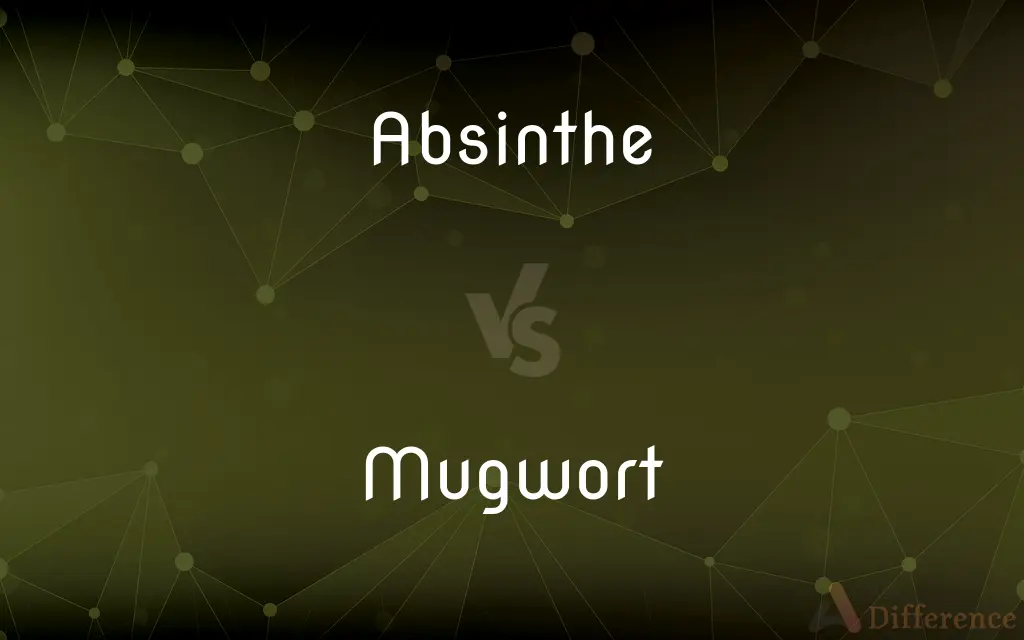Absinthe vs. Mugwort — What's the Difference?
By Fiza Rafique & Maham Liaqat — Updated on April 22, 2024
Absinthe is a distilled, anise-flavored spirit made from various herbs including wormwood, while mugwort is a bitter herb used in traditional medicine and culinary applications.

Difference Between Absinthe and Mugwort
Table of Contents
ADVERTISEMENT
Key Differences
Absinthe is primarily known as a highly alcoholic beverage, traditionally green in color and derived from botanicals, including the leaves and flowers of Artemisia absinthium (wormwood), anise, and fennel. Whereas mugwort, also a species of Artemisia, is primarily used as a herb in cooking, traditional medicine, and as a brewing ingredient in some beers.
The flavor of absinthe is often described as anise-like, due to the presence of anise and fennel, which gives it a licorice taste that is usually enjoyed diluted with water that turns the liquid cloudy. On the other hand, mugwort offers a bitter, earthy flavor, and is used for seasoning dishes, making teas, and in some cultures, for moxibustion in traditional healing practices.
Historically, absinthe was popular in late 19th- and early 20th-century France, particularly among Parisian artists and writers. It was reputed to cause a euphoric and hallucinatory effect, which contributed to its mystique and eventual legal banning in many countries in the early 1900s. Mugwort, however, has been used across various cultures for its supposed medicinal properties, including as a remedy for digestive problems and to induce vivid dreams.
Absinthe's production involves a distillation process that extracts the essences from the botanicals, which is crucial for its complex flavors and psychoactive reputed properties due to the presence of thujone, a compound found in wormwood. Mugwort does not undergo distillation but is often dried and used directly in its natural form or as an extract.
The resurgence of absinthe in the 21st century, following the lift of bans and the debunking of myths surrounding its toxicity, contrasts with the consistent but low-profile use of mugwort, which has not experienced similar prohibitions or dramatic shifts in perception.
ADVERTISEMENT
Comparison Chart
Type
Alcoholic beverage
Herb
Primary Use
Consumed as a drink
Used in cooking, medicine, and as a tea
Flavor Profile
Anise-like, licorice
Bitter, earthy
Historical Use
Popular in 19th-century France among artists
Used traditionally across various cultures
Preparation
Distilled with botanicals, diluted before drinking
Dried and used directly or made into an extract
Compare with Definitions
Absinthe
An alcoholic drink that has seen a revival in popularity.
Modern cocktail menus often feature absinthe in various creative concoctions.
Mugwort
A perennial herb with medicinal and culinary uses.
Mugwort is often used in traditional Chinese medicine for its healing properties.
Absinthe
A distilled, anise-flavored spirit made with wormwood and other botanicals.
He poured a dose of absinthe over a sugar cube to sweeten the bitter drink.
Mugwort
A bitter herb used to flavor beers and other beverages.
The brewery introduced a special beer infused with mugwort for a unique taste.
Absinthe
A beverage once banned for its alleged psychoactive effects.
Absinthe was illegal in the United States until the early 2000s.
Mugwort
Known for its supposed dream-inducing qualities.
Drinking mugwort tea before bed is popular among those seeking vivid dreams.
Absinthe
A drink traditionally prepared with a special ritual involving water and a sugar cube.
She prepared the absinthe using a traditional absinthe spoon and fountain.
Mugwort
Used in moxibustion for stimulating circulation through the points of acupuncture.
The therapist burned mugwort on my skin as part of the treatment.
Absinthe
A green, often mystical drink associated with historical artistic movements.
Absinthe was once dubbed the green fairy due to its vibrant color and supposed effects.
Mugwort
An herb used in various traditional remedies, including digestive aids.
She added dried mugwort to the pot to help soothe stomach ailments.
Absinthe
Absinthe (, French: [apsɛ̃t] (listen)) is historically described as a highly alcoholic spirit (45–74% ABV / 90–148 U.S. proof). It is an anise-flavoured spirit derived from plants, including the flowers and leaves of Artemisia absinthium ("grand wormwood"), together with green anise, sweet fennel, and other medicinal and culinary herbs.Absinthe traditionally has a natural green color but may also be colorless.
Mugwort
Mugwort is a common name for several species of aromatic flowering plants in the genus Artemisia. In Europe, mugwort most often refers to the species Artemisia vulgaris, or common mugwort.
Absinthe
A perennial aromatic Eurasian herb (Artemisia absinthium) in the composite family, naturalized in North America and having pinnatifid, silvery, silky leaves and numerous nodding flower heads. Also called wormwood.
Mugwort
Any of several artemisias, especially Artemesia vulgaris, native to Eurasia, having downy leaves and used as a flavoring and in moxibustion.
Absinthe
A green liquor having a bitter anise or licorice flavor and a high alcohol content, prepared from absinthe and other herbs, prohibited in many countries when containing thujone because of its alleged toxicity.
Mugwort
Any of several aromatic plants of the genus Artemisia native to Europe and Asia.
Absinthe
The herb absinthium Artemisia absinthium (grande wormwood); essence of wormwood.
Mugwort
Artemisia vulgaris, traditionally used medicinally.
Absinthe
(figurative) Bitterness; sorrow.
Mugwort
A somewhat aromatic composite weed (Artemisia vulgaris), at one time used medicinally; - called also motherwort.
Absinthe
A distilled, highly alcoholic, anise-flavored liquor originally made from grande wormwood, anise, and other herbs.
Mugwort
Any of several weedy composite plants of the genus Artemisia
Absinthe
(color) A moderate yellow green. 88c641
Absinthe
(US) Sagebrush.
Absinthe
Aromatic herb of temperate Eurasia and North Africa having a bitter taste used in making the liqueur absinthe
Absinthe
Strong green liqueur flavored with wormwood and anise
Common Curiosities
How is absinthe traditionally served?
Traditionally, absinthe is served using a special ritual where water is slowly dripped over a sugar cube on a slotted spoon into the glass of absinthe, diluting it and causing it to louche into an opaque, milky appearance.
Can mugwort be used in cooking, and if so, how?
Yes, mugwort can be used in cooking; it is typically used as a seasoning for meats, in stuffing, or brewed into teas for its bitter, earthy flavor.
Why was absinthe banned in many countries in the early 20th century?
Absinthe was banned due to fears about its safety and its psychoactive effects attributed to the compound thujone, found in wormwood.
Are there any dietary restrictions associated with mugwort?
People who are pregnant or have ragweed allergies should avoid mugwort due to potential adverse effects like allergic reactions or stimulation of uterine contractions.
Can mugwort be used as a sleep aid?
Yes, mugwort is often used as a sleep aid due to its purported properties to induce vivid dreams and improve sleep quality.
What effects did absinthe historically claim to have on consumers?
Historically, absinthe was said to cause hallucinations and a unique state of euphoria, contributing to its mystique and artistic associations.
How can mugwort be incorporated into modern wellness practices?
Mugwort is increasingly being incorporated into modern wellness practices through its use in herbal teas, aromatherapy, and natural health remedies focusing on digestion and menstrual health.
What are the environmental conditions suitable for growing mugwort?
Mugwort thrives in a variety of environmental conditions but prefers well-drained soil and can commonly be found in uncultivated lands and along roadsides.
What are the medicinal uses of mugwort?
Mugwort has been used for centuries to treat conditions like stomach ailments, menstrual cramps, and as an ingredient in remedies aiming to stimulate the digestive system.
How does the thujone content in absinthe affect its legality and consumption today?
Modern absinthe is regulated with limits on thujone content, making it legal and safe for consumption in many countries, including the United States and throughout Europe.
What distinguishes the taste of absinthe from other spirits?
Absinthe's distinct anise-flavored profile and herbal complexity, along with its unique preparation method, distinguish it from other spirits.
What are the cultural significances of absinthe?
Absinthe has significant cultural associations, particularly with the bohemian lifestyle of artists and writers in 19th-century Europe, symbolizing rebellion, creativity, and the avant-garde.
How has the perception of absinthe changed in modern times compared to its historical reputation?
The perception of absinthe has shifted significantly from a dangerous and mystical spirit to a respected and artisanal spirit, enjoyed for its unique taste and cultural history.
What are some popular cocktails that include absinthe?
Popular cocktails featuring absinthe include the Sazerac, the Corpse Reviver #2, and the Absinthe Drip.
Is there any scientific evidence supporting mugwort's medicinal benefits?
Some studies suggest that mugwort can offer antimicrobial and anti-inflammatory properties, though more research is needed to fully understand its medicinal benefits.
Share Your Discovery

Previous Comparison
Collection vs. System
Next Comparison
Concentric vs. CoaxialAuthor Spotlight
Written by
Fiza RafiqueFiza Rafique is a skilled content writer at AskDifference.com, where she meticulously refines and enhances written pieces. Drawing from her vast editorial expertise, Fiza ensures clarity, accuracy, and precision in every article. Passionate about language, she continually seeks to elevate the quality of content for readers worldwide.
Co-written by
Maham Liaqat












































